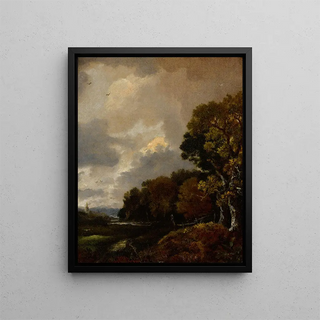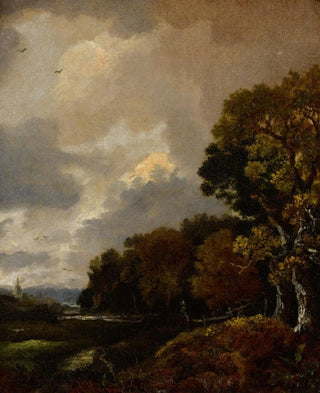Art print | Landscape with Trees and a Field, a Church Steeple in the Distance - Thomas Gainsborough


View from behind

Frame (optional)
"Paysage with trees and a field, a church steeple in the distance" by Thomas Gainsborough invites viewers to immerse themselves in a bucolic world where nature and architecture harmoniously meet. Through this canvas, Gainsborough captures the very essence of the English countryside, evoking memories of serenity and timeless beauty. The delicate hues and subtly crafted nuances transport the observer to a landscape where each element seems to live in perfect harmony. This artwork, both simple and complex, offers a poetic perspective on the relationship between man and his environment—a theme dear to the artist.
Style and uniqueness of the work
Gainsborough's style is distinguished by his ability to blend realism with a certain idealization of nature. In "Paysage with trees and a field, a church steeple in the distance," majestic trees with lush foliage are painted with an almost tactile precision, while the field extends endlessly, creating captivating visual depth. The steeple, discreet yet omnipresent, symbolizes human presence within this peaceful scene. Light plays a crucial role in this composition, with each ray caressing surfaces, revealing textures and colors with rare delicacy. This marriage of light and matter gives the artwork an almost dreamlike atmosphere, inviting contemplation and daydreaming.
The artist and his influence
Thomas Gainsborough, born in 1727, is one of the emblematic figures of 18th-century English landscape art. His artistic training, influenced by masters like Van Dyck and Rubens, allowed him to develop a unique style that combines finesse and expressiveness. Gainsborough does not merely reproduce nature; he transcends it, adding an emotional dimension that resonates deeply with viewers. His innovative approach to landscape painting paved the way for many subsequent artists, making him a pioneer in the field. By incorporating elements of everyday life into his landscapes, he also contributed to redefining the way art

Matte finish

View from behind

Frame (optional)
"Paysage with trees and a field, a church steeple in the distance" by Thomas Gainsborough invites viewers to immerse themselves in a bucolic world where nature and architecture harmoniously meet. Through this canvas, Gainsborough captures the very essence of the English countryside, evoking memories of serenity and timeless beauty. The delicate hues and subtly crafted nuances transport the observer to a landscape where each element seems to live in perfect harmony. This artwork, both simple and complex, offers a poetic perspective on the relationship between man and his environment—a theme dear to the artist.
Style and uniqueness of the work
Gainsborough's style is distinguished by his ability to blend realism with a certain idealization of nature. In "Paysage with trees and a field, a church steeple in the distance," majestic trees with lush foliage are painted with an almost tactile precision, while the field extends endlessly, creating captivating visual depth. The steeple, discreet yet omnipresent, symbolizes human presence within this peaceful scene. Light plays a crucial role in this composition, with each ray caressing surfaces, revealing textures and colors with rare delicacy. This marriage of light and matter gives the artwork an almost dreamlike atmosphere, inviting contemplation and daydreaming.
The artist and his influence
Thomas Gainsborough, born in 1727, is one of the emblematic figures of 18th-century English landscape art. His artistic training, influenced by masters like Van Dyck and Rubens, allowed him to develop a unique style that combines finesse and expressiveness. Gainsborough does not merely reproduce nature; he transcends it, adding an emotional dimension that resonates deeply with viewers. His innovative approach to landscape painting paved the way for many subsequent artists, making him a pioneer in the field. By incorporating elements of everyday life into his landscapes, he also contributed to redefining the way art






